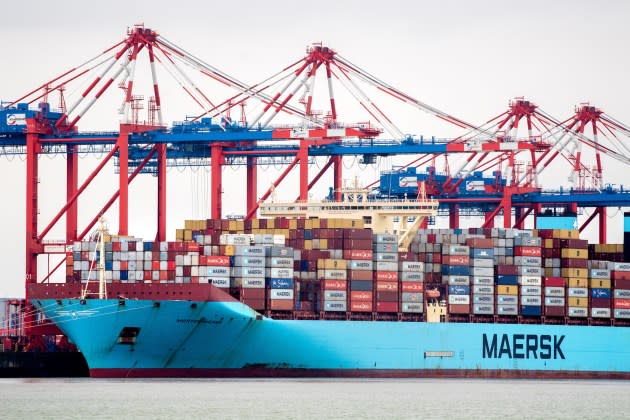Maersk CEO: Overcapacity at Sea Will Squeeze Profit Margins

The disruption in the Red Sea has given way to one apparent long-term consequence for container shipping, with ocean freight giant A.P. Moller-Maersk warning that there will be too much container capacity out at sea for the remainder of 2024.
Maersk CEO Vincent Clerc said the oversupply “will lead to price pressure,” ultimately impacting the firm’s bottom line for the year. According to Clerc, the Red Sea disruption is impacting 36 percent of the company’s ocean volumes.
More from Sourcing Journal
International Trade Groups Call for Maritime Security in Red Sea
Egypt's Suez Canal Revenue Plummeted by Almost Half in January
“The Red Sea disruption is absorbing some of the overcapacity temporarily,” said Clerc during the company’s earnings call. “However, the structural imbalance will catch up during 2024 and exacerbate over time, irrespective of whether the situation in the Red Sea endures or resolves itself.”
Despite the glut of supply out at sea, Clerc said in the call that unlike during the Covid-19 pandemic, Maersk sees “no sign of congestions or bottleneck or shifts in demand.”
“The global supply chain remains fluid and demand and supply [remain] steady,” Clerc said. “This is because there are levers today to absorb the impact without further disruption by using the capacity that was underemployed at the end of 2023,” such as gradually plugging new tonnage into existing rotations.
Maersk’s stock dropped 15 percent on Thursday in the wake of the company’s annual report, in which the shipping company anticipated that its underlying EBITDA (earnings before interest, tax, depreciation and amortization) for 2024 could be anywhere between $1 billion and $6 billion—down from $9.8 billion last year. The company also unveiled it was suspending its share buyback program and cutting its dividend.
The massive range in expected profit before tax is attributed to the uncertainty of when the ongoing Houthi attacks on commercial vessels in the Red Sea will stop, with Maersk saying that most of the income is expected to be front-loaded to start 2024. Maersk and other ocean carriers like Mediterranean Shipping Company (MSC) and future shipping alliance partner Hapag-Lloyd have instead rerouted their ships around southern Africa—tacking on roughly two weeks of travel time for many voyages.
For the fourth quarter, EBITDA dropped to $839 million versus the $1.13 billion anticipated by analysts at LSEG, formerly known as Refinitiv. The drop represents an 87.2 percent plunge from the $6.5 billion generated in the three-month period to end 2022.
Revenue saw major declines as well—falling 34.1 percent to $11.7 billion in the final 2023 quarter from $17.8 billion in the year-ago period. The revenue is reflecting of freight rates that plummeted through most of 2023 amid lower consumer demand, which persisted until the Houthi attacks and vessel reroutings sent them back up in December.
“We need to see further progress in the logistics business to align with our targets, as we continue to push our transformation forward and enhance our competitiveness,” Clerc said in a statement. “The current market remains one of robust volumes, but while the Red Sea crisis has caused immediate capacity constraints and a temporary increase in rates, eventually the oversupply in shipping capacity will lead to price pressure and impact our results.”
Clerc noted that the continued disruptions from the Houthi attacks and overall market volatility have brought a greater need for supply chain resilience, “further confirming that Maersk’s path toward integrated logistics is the right choice for our customers to effectively manage these challenges.”
Maersk expects that global container volume growth in 2024 will be in the range of 2.5 percent to 4.5 percent, forecasting that its own volume will grow in line with the market.
The Danish group said in its annual report Thursday that it will spin off its towage business Svitzer and distribute the shares to existing investors.
Maersk automates Puma’s Chilean distribution center
This week, Maersk also announced it would operate Puma’s first semi-automated omnichannel fulfilment distribution center in Santiago, Chile. Puma also will leverage Maersk’s technology to establish end-to-end visibility from its factories in the Asia Pacific region to the Chile distribution center, including middle mile.
The warehouse will give Puma quick access to the main highways and retailers in the Santiago region, in an effort to help the footwear brand’s customers better serve their local markets.
Maersk’s integrated logistics capabilities will assist Puma in overseeing inventories at origin, in transit and at the destination, with the fulfillment center incorporating the ocean carrier’s warehouse management system (WMS). This integrated system will offer real-time reports to give the footwear seller more control over order processing, reporting and stocking.
The system supports customer-driven customizations, and can track activities across one or multiple facilities, from dock arrival to customer delivery. By leveraging real-time data and advanced automation, the solution aims to optimize inventory management, order processing and shipping logistics for Puma.
